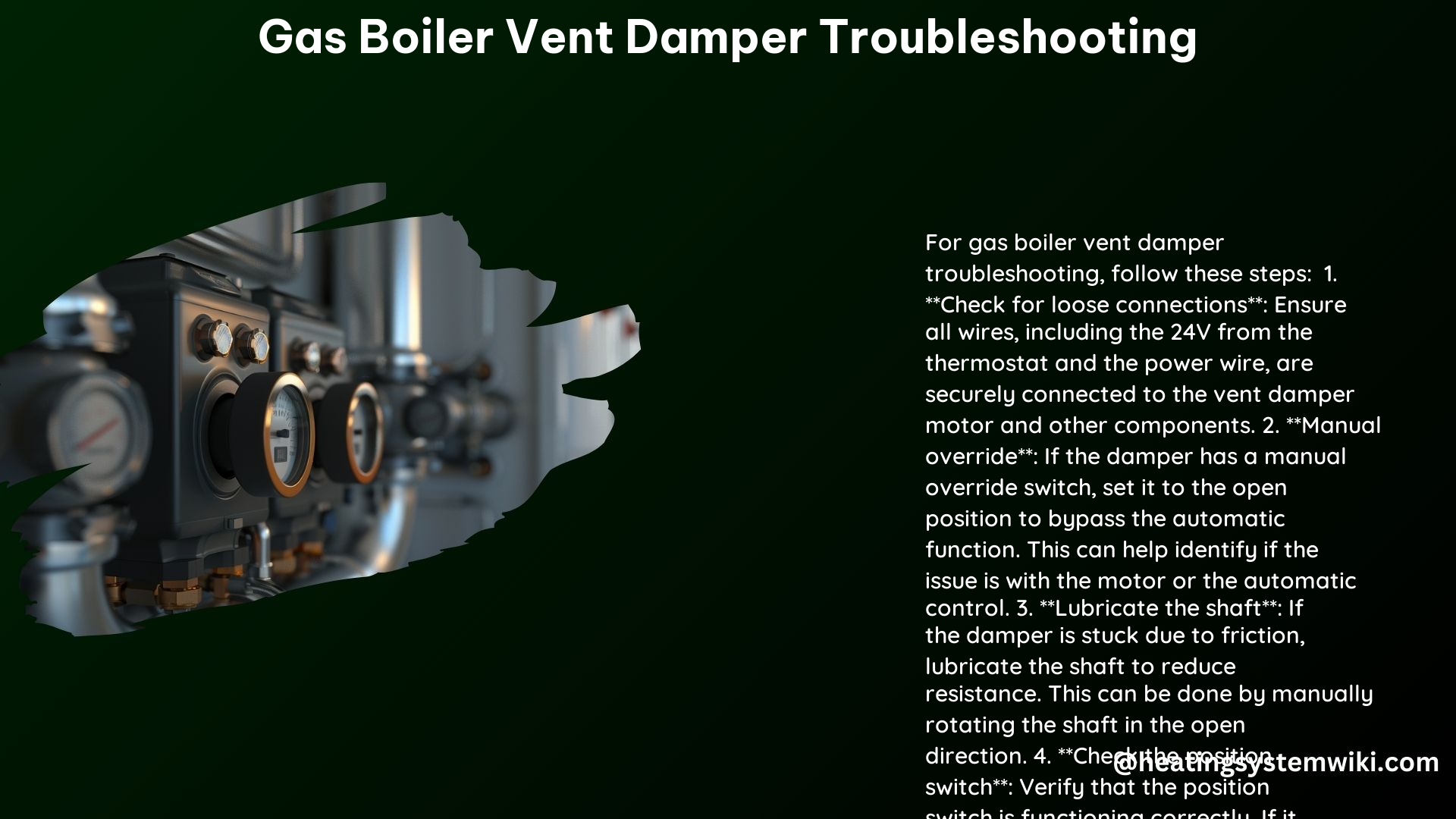A gas boiler vent damper is a critical component that ensures safe and efficient operation by controlling the flow of combustion gases. Troubleshooting a faulty vent damper can be a complex task, but with the right approach and knowledge, it can be done effectively. This guide provides advanced hands-on details and technical specifications for troubleshooting a gas boiler vent damper.
Common Signs of a Faulty Vent Damper
- Boiler Failure to Start: If the vent damper is stuck or malfunctioning, the boiler may not start or may shut down frequently. This can be due to a variety of issues, such as a faulty damper motor, a stuck damper shaft, or a problem with the position switch.
- Error Codes: Check the boiler’s control panel for error codes indicating vent damper issues. Common error codes may include “E03,” “E04,” or “E05,” which can signify problems with the vent damper.
- Increased Energy Bills: A faulty vent damper can lead to reduced efficiency, resulting in higher energy bills. This is because the damper may not be opening or closing properly, causing the boiler to work harder and consume more fuel.
- Unusual Noises: Abnormal sounds from the vent damper or boiler, such as grinding, squeaking, or rattling, can indicate a problem with the vent damper.
Troubleshooting Steps

- Verify Power Supply: Ensure the vent damper is receiving the correct voltage (typically 24V) by checking the transformer, wiring, and connections. Use a multimeter to measure the voltage at the damper terminals.
- Check for Loose Wires: Inspect the wires connecting the vent damper to the gas valve and thermostat for any signs of wear, damage, or loose connections. Tighten any loose connections and replace any damaged wires.
- Inspect the Damper Motor: Look for signs of wear, corrosion, or damage on the damper motor and its components, such as the gears, bearings, and shaft. Check the motor’s resistance using a multimeter to ensure it is within the manufacturer’s specifications.
- Check the Damper Shaft: Ensure the damper shaft is not stuck or seized by manually rotating it. If the shaft is difficult to move, apply a small amount of lubricant to the shaft and bearings.
- Test the Position Switch: Verify the position switch is functioning correctly by manually rotating the damper shaft and checking that the switch changes state (open/closed) as the shaft moves.
- Consult the Troubleshooting Flowchart: Refer to the manufacturer’s troubleshooting flowchart or a similar resource to systematically guide the troubleshooting process. This can help identify the root cause of the issue and the appropriate corrective action.
Manually Opening a Gas Boiler Vent Damper
- Locate the Manual Override Switch: Find the manual override switch on the vent damper motor housing. This switch is typically labeled “Manual” or “Auto.”
- Set the Switch to Manual: Move the switch to the manual position, which will disengage the motor and allow you to manually operate the damper.
- Rotate the Damper Shaft: Use a pair of pliers or a wrench to manually rotate the damper shaft to the open position. Ensure the damper is fully open to allow proper combustion gas venting.
- Secure the Damper: Once the damper is in the open position, secure it in place to prevent it from closing accidentally. This can be done by using a clamp or other suitable device.
Technical Specifications
- Vent Damper Types: Common types of gas boiler vent dampers include FieldControl, Effikal, and GVD-7. Each type may have slightly different technical specifications and troubleshooting procedures.
- Voltage and Wiring: Typically, gas boiler vent dampers operate on 24V AC power. They have four wires: two from the transformer, one from the thermostat, and one to the boiler limit circuit.
- Motor and Gearbox: The damper motor and gearbox should be inspected for signs of wear or damage, such as worn bearings, stripped gears, or corrosion. The motor’s resistance should be within the manufacturer’s specified range.
- Position Switch: The position switch, which senses the damper’s open and closed positions, should be checked for proper operation and alignment. The switch should change state (open/closed) as the damper shaft rotates.
Additional Resources
- YouTube Videos:
- “How to Troubleshoot a Faulty Vent Damper on a Gas Boiler” by Interplay Learning: https://www.youtube.com/watch?v=ow0N0d6UFDU
- “Stuck Automatic Vent Damper – Gas Boiler” by Mikey Pipes: https://www.youtube.com/watch?v=QeB70TKsVqY
-
“Gas Boiler Vent Damper Troubleshooting Video” by Interplay Learning: https://www.youtube.com/watch?v=2FrAMzgIuu0
-
Forums and Discussions:
- “Help Vent Damper Failed – Can I override to get us through the night?” on HeatingHelp.com: https://forum.heatinghelp.com/discussion/152801/help-vent-damper-failed-can-i-override-to-get-us-through-the-night
- “Boiler vent damper not closing” on DoItYourself.com: https://www.doityourself.com/forum/boilers-home-heating-steam-hot-water-systems/578030-boiler-vent-damper-not-closing.html
References
- Interplay Learning. (2018, December 10). How to Troubleshoot a Faulty Vent Damper on a Gas Boiler – YouTube. Retrieved from https://www.youtube.com/watch?v=ow0N0d6UFDU
- HeatingHelp.com. (2014, December 22). Help Vent Damper Failed – Can I override to get us through the night? Retrieved from https://forum.heatinghelp.com/discussion/152801/help-vent-damper-failed-can-i-override-to-get-us-through-the-night
- Mikey Pipes. (2016, March 8). Stuck Automatic Vent Damper – Gas Boiler – YouTube. Retrieved from https://www.youtube.com/watch?v=QeB70TKsVqY
- Interplay Learning. (2015, February 18). Gas Boiler Vent Damper Troubleshooting Video – YouTube. Retrieved from https://www.youtube.com/watch?v=2FrAMzgIuu0
- DoItYourself.com. (2017, March 24). Boiler vent damper not closing – DoItYourself.com Community Forums. Retrieved from https://www.doityourself.com/forum/boilers-home-heating-steam-hot-water-systems/578030-boiler-vent-damper-not-closing.html
